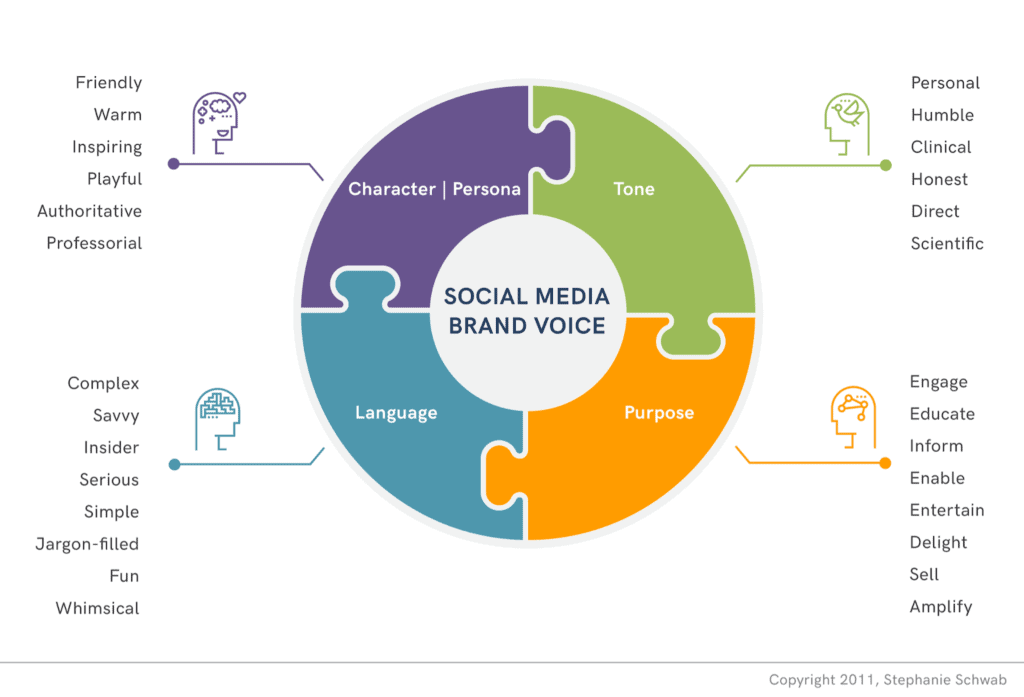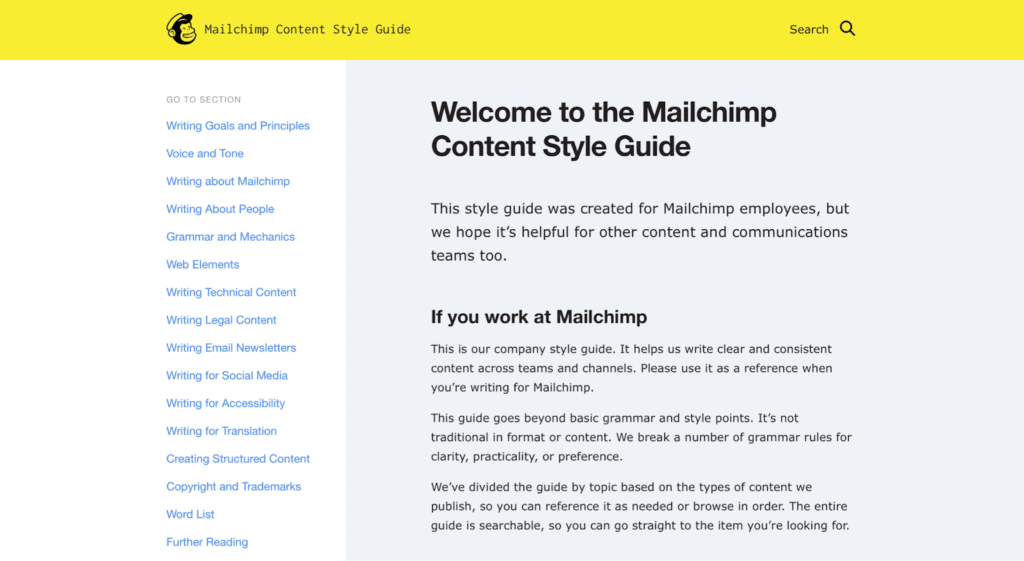If your content team is growing, then props! That’s a great sign that you’ve created an effective product or built a successful company. Give yourself a pat on the back for surpassing expectations and crushing your goals.
That sort of progress doesn't come without its own obstacles though. Bringing on new people means you now have more contributors creating content. The problem is that your new hires or freelancers might not be familiar with the established brand voice you use, or how to write appropriately for the different types of content you use to build your brand.
That’s why learning how to create a content style guide is so important. Creating this document will help you transfer over all your writing knowledge to new writers in a way that helps you maintain your brand voice, no matter who’s writing your content.
Why your brand voice matters
Your brand voice is the way you represent your company to your customers and to the whole world. It’s what differentiates you from your competition or any other brand in your space.
You’ve likely seen examples of brands with a killer brand voice in your own life, even if you haven’t been paying close attention to them. Wendy’s Twitter account is nothing short of legendary for its social media presence. And people sign up for Buzzfeed’s email lists because their emails are consistently entertaining.
Brands like these succeed at having unique voices because they've worked hard to cultivate them and have made efforts to stay consistent. If a company didn’t bother to put together a content style to ensure consistency, it’s safe to say they wouldn’t be a great example or be recognized as a thought leader. They might actually end up leaving their audience confused about who they are.
Imagine if you spoke so drastically differently to a few friends every time you saw them, never using the same words. Sometimes you sound sophisticated, and other times you drop nothing but slang. They probably wouldn’t know what to make of you, limiting how deep of a relationship they’d be willing to build with you.

Source: Uscreen
For a business example, if a customer loves the humor and casual nature of your social media posts, how do you think they’ll react to sales emails that feel like spam, or blog posts that sound like a snobby senior thesis? That sort of disconnect not only waters down your brand consistency and lessens your customer’s trust.
So how do you make sure everything your company writes makes sense and meets the same standard?
The only way is to create a content style guide. This document gives a general overview of your brand, educates content creators on your brand’s personality, and sets strict formatting guidelines for everyone to follow.
What is a content style guide?
A content style guide (or content marketing style guide) is a brand’s bible, the authoritative document that breaks down the different pieces and components that make up the company’s identity or brand personality. It lists all the writing guidelines, style rules, grammar rules, formatting rules, and brand voice and tone guidelines content writers must follow in the content creation process.
What to include in your own style guide
But enough buildup. You’re here to learn how to create a content style guide. So let’s look at the key pieces you can include:
An introduction to your company and brand story
Sure, this is a bit of a given. At this point whoever’s working with you should already know about your company. But it’s important to cover these basics before you dive into other topics in your content style guide.
In this section, share your company’s mission statement, a 1-2 sentence explanation of why you do what you do.

Source: SimonSinek.com
This section is also a good place to talk about specific brand messaging, language, or phrases that are important to your brand, like your slogan. If there is a foundational piece of the brand or company values, you’ll need to represent that in a content style guide to make sure everyone knows and appreciates those details.
Explain on who your audience is
Buyer personas have become an invaluable piece of any marketing strategy. These help split up your diverse group of people interested in your business into smaller groups. The more that writers can understand your audience, the better they can write to appeal to them.
The more detail you can provide in your own guide, the better. It’s hard to cover every little detail sometimes, but you’ll want to at least touch on each persona that you consider an “ideal” customer. That means including information like:
- Demographic: Provide some background information on who they are in terms of age, gender, location they live in, phase of life they’re in
- Needs: Think about what basic needs they’re trying to fulfill when they engage with your business
- Goals: List possible motivations - what pain they’re trying to avoid, or pleasure they’re trying to seek when they buy your product or service
- Challenges: Share some potential hurdles they might face
As your company continues to evolve, you may target personas with unique pieces of content like a blog post or weekly newsletter, and this understanding of personas needs to be reflected in every piece of content.
This is the exact reason why you want to include that information in a universal document that will be given to new team members and content collaborators — by speaking to the right audience in the right tone and overall voice, all your writers can be on the same page when representing your company.
Mention who your competitors are
You don’t need to spend too much time highlighting other organizations in your market. But drawing attention to those brands in a section of your content style guide can be a valuable resource for new contributors. It will help your content creators understand how your voice needs to be different from what else is out there.
You can gather information about your competitors in a few different ways, some of the most popular are through:
- Keyword research: Find out your competitors’ SEO focus
- Social listening: See how your competitors engage their audience
- Customer surveys: Learn which competitors your customers know of
It’s also important to talk about what makes your company different. These are usually “calling cards” to include in most pieces of content, because they are the value proposition that make your company’s product stand out above the competition or any other alternative.
By understanding who you compete with, new writers will be able to comprehend your industry as a whole, and what it is that makes your brand unique.
Talk about your standards
Here’s the nitty-gritty part of the style guide where you get to break down all of the rules and guidelines you want your writers to follow.
This could be best practices for using things like Associated Press Style (AP style) or Chicago, or what proper nouns to use. Maybe you have a specific opinion on the Oxford comma or when to write out numbers in text.
Check out Mailchimp’s content writing style guide below as a great example.

Source: Mailchimp's content style guide
This is also your chance to standardize some of the more subjective pieces of your brand’s voice. This could be anything from formatting expectations to preferred verbiage. Here are a few ideas for things you might want to include:
- Baseline guide (Associated press (AP Style), Chicago, etc.)
- Important keywords or slogans
- Phrases/terms to avoid
- Preferred tone (playful, sarcastic, academic, etc.)
- Headline formatting
- Paragraph structure/length
- Bulleted and/or numbered list formatting
- How to use hyphens or parentheticals
- Image requirements (alt text, standardized sizing, etc.)
- If and when emojis are used
If there is something that sets your brand voice apart, now’s your time to share that secret formula with people who are going to be working with you on content in this formatting section.
Explain how to write for different mediums
Since your content creators probably work on many different types of content, you’ll want to use your style guide to be specific and explain how the writing should be different depending on the medium. For example, you might have a section that provides a style guide for website content that’s different from your rules for print content.
Doing this also allows you to provide examples for each type of content. Even if it’s just a small screenshot (or a direct link from the PDF), you’ll be able to give very clear content on what works and what doesn’t work for your brand depending on the medium.
Remember that style guides evolve with time
Your content style guide will be shared across the company, so it needs to be a living document — something like the U.S. Constitution, an encyclopedia, or even a Wikipedia article that can easily be updated. Your brand voice and brand style will change as your company and audience changes, and that means parts of your brand’s style guide will need to evolve too.
That’s why a centralized document matters. Sure, it’s great to have a guide to point to when someone asks for a weird edit or wants to write content that doesn’t line up with your brand voice. But having a shareable, editable style guide is a pro tip that will serve you well in the future.
With these four sections in mind, you’re ready to start creating a content style guide for your company and start shaping the future for how people will perceive your brand moving forward.
Which piece of a content style guide that we shared in this post do you think would benefit your team the most? If you don’t have an existing style guide already, how do you think a centralized “rulebook” will help you collaborate with coworkers and partners? Let us know in the comments below!



